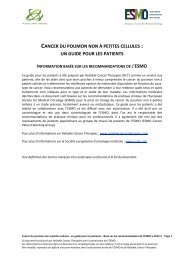Bladder cancer - European Society for Medical Oncology
Bladder cancer - European Society for Medical Oncology
Bladder cancer - European Society for Medical Oncology
You also want an ePaper? Increase the reach of your titles
YUMPU automatically turns print PDFs into web optimized ePapers that Google loves.
cisplatin* and causes fewer side effects* in patients. It attaches to DNA in cells and may kill <strong>cancer</strong><br />
cells. It is a type of platinum compound. Also called Paraplatin.<br />
Catheter<br />
A tube that can be inserted into the body. It has many uses, including draining or administering fluids<br />
or gases.<br />
Chemotherapeutic/Chemotherapy<br />
A type of <strong>cancer</strong> treatment using drugs that kill <strong>cancer</strong> cells and/or limit their growth. These drugs<br />
are usually administered to the patient by slow infusion into a vein but can also be administered<br />
orally, by direct infusion to the limb or by infusion to the liver, according to <strong>cancer</strong> location.<br />
Cisplatin<br />
A drug used to treat many types of <strong>cancer</strong>. Cisplatin contains the metal platinum. It kills <strong>cancer</strong> cells<br />
by damaging their DNA and stopping them from dividing. Cisplatin is a type of alkylating agent. Also<br />
called Platinol.<br />
Clinical examination<br />
The examination of the body to search <strong>for</strong> signs of disease.<br />
Contraindication<br />
Condition or symptom that prevents the administration of a given treatment or procedure to the<br />
patient. Contraindications are either absolute, meaning the treatment should never be given to<br />
patients with this condition or symptom, or relative, meaning that the risk can be outweighed by the<br />
benefits in some patients with this condition or symptom.<br />
Computed tomography/ CT‐scan<br />
A <strong>for</strong>m of radiography in which body organs are scanned with X‐rays* and the results are synthesized<br />
by a computer to generate images of parts of the body.<br />
Cystitis<br />
Inflammation of the bladder.<br />
Cystoscopy<br />
Examination of the bladder and urethra* using a cystoscope, inserted into the urethra. A cystoscope<br />
is a thin, tube‐like instrument with a light and a lens <strong>for</strong> viewing. It may also have a tool to remove<br />
tissue to be checked under a microscope <strong>for</strong> signs of disease.<br />
Diabetes<br />
Any of several diseases in which the kidneys make a large amount of urine. Diabetes usually refers to<br />
diabetes mellitus in which there is also a high level of glucose (a type of sugar) in the blood because<br />
the body does not make enough insulin or use it the way it should.<br />
Doxorubicin<br />
A drug that is used to treat many types of <strong>cancer</strong> and is being studied in the treatment of other types<br />
of <strong>cancer</strong>. Doxorubicin comes from the bacterium Streptomyces peucetius. It damages DNA and may<br />
kill <strong>cancer</strong> cells. It is a type of anthracycline antitumor antibiotic. Also called Adriamycin PFS,<br />
Adriamycin RDF, doxorubicin hydrochloride, hydroxydaunorubicin, and Rubex.<br />
<strong>Bladder</strong> <strong>cancer</strong>: a guide <strong>for</strong> patients‐ In<strong>for</strong>mation based on ESMO Clinical Practice Guidelines ‐v.2012.1 Page 22<br />
This document is provided by Reliable Cancer Therapies with the permission of ESMO.<br />
The in<strong>for</strong>mation in this document does not replace a medical consultation. It is <strong>for</strong> personal use only and cannot be modified,<br />
reproduced or disseminated in any way without written permission from ESMO and Reliable Cancer Therapies.
















